Common menu bar links
Breadcrumb Trail
ARCHIVED - National Round Table on the Environment and the Economy
 This page has been archived.
This page has been archived.
Archived Content
Information identified as archived on the Web is for reference, research or recordkeeping purposes. It has not been altered or updated after the date of archiving. Web pages that are archived on the Web are not subject to the Government of Canada Web Standards. As per the Communications Policy of the Government of Canada, you can request alternate formats on the "Contact Us" page.
Section 2: Analysis of Program Activity by Strategic Outcome
2.1 NRTEE Strategic Outcome
As previously outlined in section 1.2, the NRTEE has a single Strategic Outcome as approved by the Treasury Board of Canada Secretariat (TBS). It is as follows:
| Federal policy development and decisions in other key sectors are influenced by advice on sustainable development issues pertaining to the environment and the economy |
The key indicator of the NRTEE's overall performance against its Strategic Outcome is the extent to which NRTEE's advice is considered in federal policy decisions and its research results are used in the development of policy recommendations.
The Program Activity that pertains to this Strategic Outcome is:
| Advisory Program on environment and economy issues |
The NRTEE's approach to achieving its Strategic Outcome consists of producing and promoting its policy advice, and, in all aspects of its work, applying sound management practices. The NRTEE's goal is to increase the understanding of decision makers about challenges and opportunities at the interface of the environment and the economy, and to inform the debate on those questions.
The NRTEE is in the unique position of being an independent policy advisory agency that advises the federal government on sustainable development solutions. It raises awareness among Canadians and their governments about the challenges of sustainable development by advocating for positive change and strives to promote credible and impartial policy solutions that are in the best interest of all Canadians.
During 2008–2009, the NRTEE engaged federal departments, agencies, and key national, provincial, and territorial stakeholders in our research and ideas generation. Throughout the course of its work, the NRTEE has continued to suggest ways to make environmental and economic concerns a central plank of the government's decision-making processes and encourage the adoption of its recommendations.
The NRTEE Performance Measurement Framework
The performance measurement framework, presented in Figure 3, identifies the performance indicators for the single Strategic Outcome and each result and output contributing to this outcome.
Figure 3: NRTEE Performance Measurement Framework
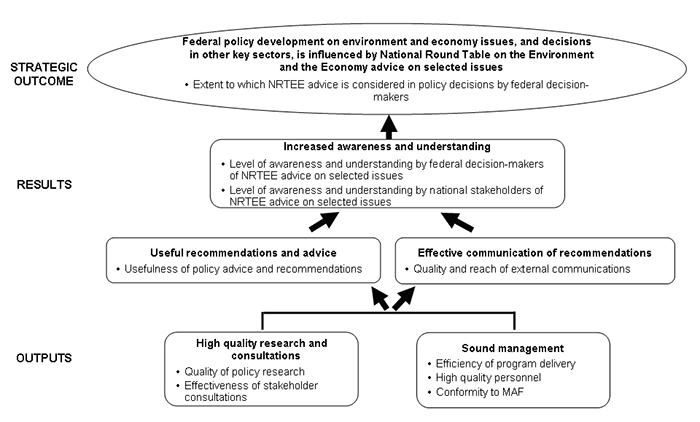
2.2 Program Activity Summary
The summary that follows reflects the three core areas of NRTEE activity: Produce Advice, Promote Advice, and Apply Sound Management Practices.
The expected results for each of these three core activities, outlined below, are in accordance with the NRTEE's Performance Measurement Framework, as illustrated in Figure 3.
Produce Advice
Producing advice entails conducting original research, convening experts and stakeholders to ensure balance and credibility. The research analyzes the environmental and economic facts and trends underlying each issue. The resulting policy recommendations are reviewed and approved by NRTEE members. The culmination of this effort is a report that presents the findings, analysis, and recommendations from the research and consultation process and the consensus of members.
Expected Results and Outputs (as illustrated in Figure 3: NRTEE Performance Measurement Framework)
|
(a) Generate Policy Advice
In 2008–2009, the NRTEE successfully undertook a variety of activities through a range of targeted initiatives to achieve its expected results.
- Developing Ambient Air Quality Objectives for Canada: This advisory note released in June 2008 completed the NRTEE's work in response to the Government of Canada's
request for advice on long-term climate change and clean air strategies for Canada, as set out in the government's Regulatory Framework for Air Emissions (April 2007).
- Greenhouse Gas Emissions Forecasting: Learning from International Best Practices: In this publication released in 2008, the NRTEE offered lessons on how Canada can
continue to improve its approach to emissions forecasting. The report examined how other countries approach similar forecasting challenges to those faced by the federal
government.
- 20th Anniversary Forum entitled Securing Canada's Future in a Climate-Changing World: On October 30, 2008, the NRTEE commemorated its twentieth anniversary by holding a
forum to discuss Canada's next steps climate policy agenda. The forum gave over 100 leading Canadians a chance to discuss how climate change would affect Canada's ecosystems, energy
economy, and Arctic environment. A report setting out what was heard at the forum and offering observations from the NRTEE for Canada's next steps climate policy agenda, called
Climate Forward, was released in the next fiscal year.
- Geared for Change: Energy Efficiency in Canada's Commercial Building Sector: The NRTEE worked collaboratively with Sustainable Development Technology Canada (SDTC) to
develop a policy pathway to help maximize the use of existing technologies to reduce energy use and GHG emissions. The report represented a major step in addressing the realities
facing the commercial building sector in Canada as it moves to address challenges like emissions and energy consumption.
- Carbon pricing: Over 2008 and the winter of 2009 the NRTEE conducted groundbreaking research into the ways in which Canada can meet the government's goals for greenhouse gas (GHG) reduction targets, for 2020 and 2050. The results were published in April 2009 as Achieving 2050: A Carbon Pricing Policy for Canada, which recommended an economy-wide cap-and-trade system to meet our environmental targets at least economic cost.
In 2008–2009, the NRTEE did not meet its proposed deadline for completion of its report Adaptation of Northern Infrastructure to Climate Change. There were unanticipated challenges in bringing together a range of research findings into a cohesive report that met both stakeholders' and NRTEE members' expectations. Work on this important issue has continued and the report is expected to be released in the fall of 2009.
In 2008–2009, the NRTEE commenced research and scoping work on two new major multi-year policy research areas: Economic Risks and Opportunities of Climate Change for Canada, and Water Sustainability and the Future of Canada's Natural Resource Sectors.
More information about each of these specific initiatives and related reports available for download can be found on the NRTEE website at www.nrtee-trnee.ca.
(b) Comply with Bill C-288
In July 2008, the NRTEE complied with its legislated responsibilities under the Kyoto Protocol Implementation Act (KPIA). This was the NRTEE's second response to its obligations under KPIA.
The NRTEE response may be found at http://www.nrtee-trnee.ca/eng/publications/KPIA-2008/kpia-2008.pdf.
(c) Respond to Government References
In 2008–2009 the NRTEE was not called upon to respond to any government research requests.
(d) Establish a Strategic Outlook Function
Progress was made toward the planned establishment of a strategic outlook function. However, due to competing pressures, this has yet to be fully implemented and will be pursued in 2009–2010.
Promote Advice
On completion of an activity, the agency promotes its findings and advice through a variety of communications channels to reach targeted decision makers and opinion leaders across the country. This step is crucial for raising awareness and understanding and for influencing policy development. The NRTEE maintains and updates networks of selected individuals and stakeholder groups as a starting point for these activities.
Expected Results and Outputs (as illustrated in Figure 3: NRTEE Performance Measurement Framework)
|
(a) Maintain Program and Corporate Communications Activities
Based on the performance data collected for 2008–2009, the NRTEE was successful in achieving its expected results for the fiscal year.
Despite its limited resources the NRTEE increased its overall communications profile and activities, supporting the release of the Round Table's reports, revamping the website with a new look and improved functionality, and communicating advice regularly and directly with stakeholders.
The 20th Anniversary Forum was a major public event for the Round Table in the fall of 2008. The NRTEE communications section brought both media and public attention to the proceedings. This included full taped coverage from CPAC, allowing a wide audience across Canada to see the proceedings that were also made available on the NRTEE website.
(b) Improve Strategic Communications
Media relations are a key aspect of the work of the NRTEE communications team. In 2008–2009 the Round Table achieved significant presence in national and regional media both from a general corporate perspective (eight-fold from the prior year — see Table 6 for more details) and in support of its various reports, especially the 20th Anniversary Forum and Achieving 2050.
| Program or Publication | Number of Media References | Media Sources |
|---|---|---|
| 20th Anniversary Forum: Securing Canada's Future in a Climate-Changing World | 25 | Canadian Press (8 mentions), SRC (Radio-Canada) "Le monde selon Mathieu," Canada News Wire "Media Day Book," Le Journal de Montr�al, SRC-T�l�vision, CanWest, CBC Radio "The House," CFRA News Talk Radio, New Brunswick Telegraph-Journal, Ottawa Citizen, SRC (Radio-Canada) Sudbury "Le train du matin," SRC (Radio-Canada) Edmonton "Le caf� show," OKalaKatiget Radio Labrador, Environmental Dimensions News Report, BNA, CPAC, Environment Canada website, Le Soleil |
| Geared for Change: Energy Efficiency in Canada's Commercial Building Sector | 17 | 1130 News Vancouver, Canada.com, CMHC Newsletter February Issue, CNW, Canadian Press, Edmonton Journal, Green Business News, Le Soleil, Ottawa Citizen, The Gazette (Montr�al), Le Journal de Montr�al, SRC (Radio-Canada) Calgary, SRC (Radio-Canada) "Ontario aujourd'hui," SRC (Radio-Canada) "Maisonneuve en direct," EcoLog News, CBC Radio "The House" |
|
NRTEE Corporate
(Mentions of the NRTEE and/or its members – not related to policy programs) |
163
(up from 22 in 2007–08) |
Vancouver Sun, Canadian Press, Ottawa Citizen, La Presse, Calgary Sun, Whitehorse Daily Star, Kingston Whig-Standard, Edmonton Journal, Toronto Sun, The London Free Press, Ottawa Sun, Winnipeg Sun, Red Deer Advocate, The Globe and Mail, Waterloo Region Record, New Brunswick Telegraph-Journal, Chronicle Herald, Le Soleil, The Gazette, Times & Transcript, Winnipeg Free Press, Le Devoir, The Telegram, Toronto Star, Le Journal de Montr�al, Daily Gleaner, L'Acadie Nouvelle, The Guardian, Edmonton Sun, The StarPhoenix, National Post, Calgary Herald, Times Colonist, La Voix de l'Est, Le Nouvelliste |
A significant factor in this success was the focus NRTEE communications has placed on the Round Table's website. The site was redesigned to create a tool that would be easier for stakeholders to navigate and find information by focusing on delivering targeted, relevant, and important information that is updated regularly. The website has continued to develop and improve in response to stakeholders' needs.
In conjunction with the redesign of the website, the NRTEE acted to make electronic access to its reports easier. Electronic distribution of reports has many advantages over traditional printing, saving costs and using less paper. It also makes it possible for the NRTEE to communicate its work immediately to its stakeholders. The most requested NRTEE documents in 2008–2009 were Getting to 2050: Canada's Transition to a Low-emission Future (4275 downloads – April 2008 to March 2009), Geared for Change: Energy Efficiency in Canada's Commercial Building Sector (2006 downloads – January to March 2009) and materials for the 20th Anniversary Forum (3068 Forum Guides and 2451 Forum Commentaries downloaded – October 2008 to March 2009). This trend toward e-publishing continues with the advisory report Achieving 2050: A Carbon Pricing Policy for Canada, which has been downloaded over 17,000 times in the four-month period following its release on April 16, 2009. The 120 page technical background report in support of Achieving 2050 was downloaded over 10,000 times.
In direct response to feedback from stakeholders in 2007–2008 the NRTEE undertook concrete steps to raise its presence and profile in Quebec in 2008–2009. A network of approximately 15 key stakeholders (from industry, non-governmental organizations, and academia) operating in Quebec was created and met to discuss NRTEE's initiatives. The NRTEE will continue to proactively engage this network in 2009–2010.
(c) Pursue Collaborative Arrangements with Other Organizations
In 2008–2009, the NRTEE entered into a collaborative and cost-shared arrangement with Sustainable Development Technology Canada (SDTC) to produce and disseminate its work on energy efficiency in commercial buildings. This extended the NRTEE's reach and effectiveness by providing additional resources and access to a wider network of stakeholders.
Regional stakeholders were engaged in the outreach elements of program delivery to further raise and extend the profile and effectiveness of the NRTEE's work.
Regional consultation sessions on the NRTEE's carbon pricing research were held in the fall of 2008. Following the release of the Geared for Change report on energy efficiency in
the commercial building sector, partnered sessions with local and regional stakeholders were also held to promote the report and its findings.
Apply Sound Management Practices
With limited staff and a small budget, the agency takes seriously its responsibility to ensure that the stewardship of its financial and human resources is effective and aligned with government-wide initiatives.
Expected Results and Outputs (as illustrated in Figure 3: NRTEE Performance Measurement Framework)
|
The key focus in 2008–2009 was the implementation of internal organizational changes to better position the NRTEE in terms of increased policy capacity and focus. Clear alignment of responsibilities and accountability of staff and positions occurred. Risk assessment and management continues to be done on a relatively informal basis, something the small size of the agency enables.
Another enhancement that the NRTEE introduced in 2008–2009 was the members-only secure website called Members' Corner. Accessible through the NRTEE's public website, the members-only website provides NRTEE members with direct access to specialized information so they may carry out their work more effectively and efficiently.
In 2008–2009 the NRTEE had no significant findings to address from audits or evaluations; all were deemed as satisfactory, meeting necessary requirements.
The NRTEE commenced work on establishing its own carbon footprint inventory and baseline in anticipation of a move toward future GHG reductions in its operations.
2.3 Summary of Performance by Indicator
Table 7 illustrates the results achieved by the NRTEE in relation to its Program Activity, as well as highlights of its performance, according to the indicators specified in the Performance Measurement Framework. Results are based on independent survey feedback (see section 2.4), internal reviews, and assessments.
| Expected Results and Outputs | Performance Indicators | Performance Level |
|---|---|---|
| Produce Advice | ||
| High quality research | Perceived quality of research | Met all |
| Effective consultations | Extent of consultations Effectiveness of consultations |
Mostly met |
| Useful recommendations and results | Perceived usefulness Perceived independence of NRTEE Demand for NRTEE advice |
Mostly met |
| Promote Advice | ||
| Effective communication of recommendations | Reach of recommendations Quality of communications |
Mostly met |
| Increased awareness and understanding of issues and solutions | Awareness of issues and solutions Understanding of issues and solutions |
Mostly met |
| Apply Sound Management Practices | ||
| Effective stewardship of NRTEE financial and human resources | Efficiency of program delivery High quality personnel |
Mostly met |
2.4 Feedback
Feedback from Survey of Federal Decision Makers and Members
Feedback on the NRTEE's performance on producing advice is generally positive. Its research is considered to be timely, relevant, and of high quality. Recommendations were felt to be
balanced and useful.
There was some feeling that the reach of the NRTEE could be broadened to a wider audience, both within government and to the public more generally. It was felt that the NRTEE plays a
unique and important advisory role, but there was some uncertainty and a desire for more specific evidence to assess any direct influence on federal policy decision-making outcomes. This
difficulty in directly attributing efforts to results is an ongoing and systemic challenge of independent policy and research organizations.
Results of Other Surveys
Figures 4 and 5 demonstrate the results of feedback received from participants who were present at numerous NRTEE stakeholder sessions throughout the year, as well as at the NRTEE 20th Anniversary Forum held in October 2008. The two questions asked of participants illustrate their responses in the areas of NRTEE influence and relevance.
The survey results shown in the two figures clearly demonstrate that stakeholders were generally positive in terms of their perceptions of the NRTEE's potential impact and relevance. The relatively high percentage of "neutral" responses could be due to the challenge of clearly attributing changes in government policy directly to the NRTEE's efforts in areas of policy that are intangible and difficult to measure, and in an environment where so many factors are at play.
Nevertheless, there is strong agreement among stakeholders that the NRTEE's work is relevant and useful. For example, the government has made improvements to its GHG emissions forecasting methodology based on NRTEE advice. Policy options and research produced by the NRTEE have also been considered by federal departments.
Figure 4: Survey Results for Statement "The NRTEE's work has a significant impact on the way that key decision makers in Canadian governments think about issues that affect the environment and the economy"
Answers from participants from various NRTEE outreach sessions (October 2008 – March 2009)
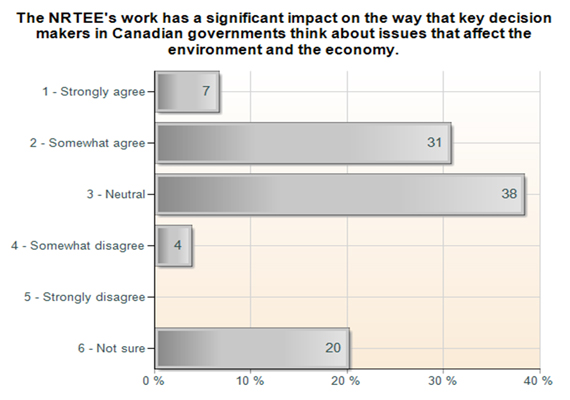
Answers from participants at NRTEE 20th Anniversary Forum (October 2008)
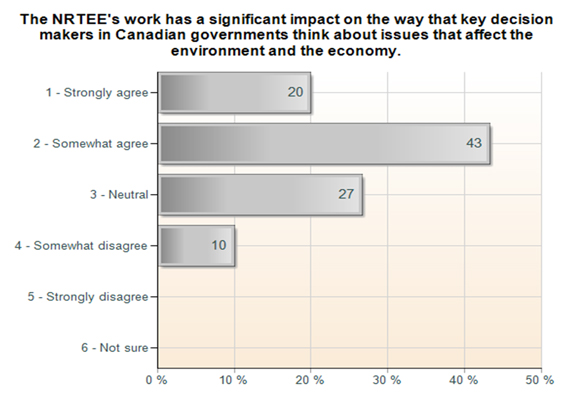
Figure 5: Survey Results for Statement "I believe that the NRTEE's work is highly relevant to key issues that affect Canada's capacity to address challenges related to the environment and the economy"
Answers from participants from various NRTEE outreach sessions (October 2008 – March 2009)
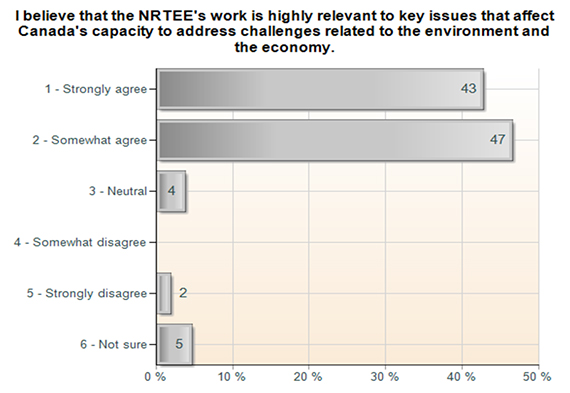
Answers from participants at NRTEE 20th Anniversary Forum (October 2008)
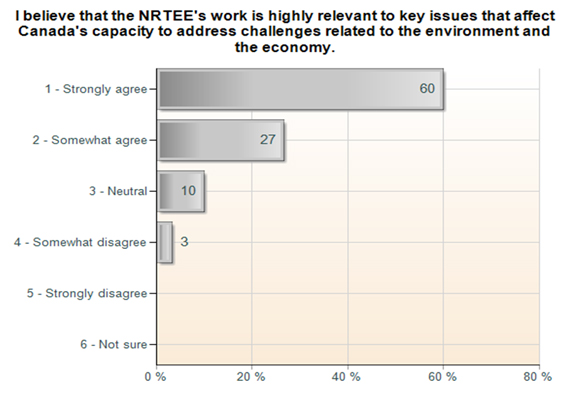
2.5 Benefits for Canadians
The NRTEE benefits Canadians by addressing an issue of critical importance, namely sustainable development. The agency provides recommendations to decision makers with the ultimate goal of influencing policy on issues at the nexus of the environment and the economy. These recommendations, if implemented, are consistent with Canada's national interest and the government's objective of building a globally competitive, sustainable, technologically innovative economy.
2.6 Performance Analysis
Based on objective evidence and the feedback from the surveys of members and decision makers, the NRTEE is seen to be producing high quality, relevant research and communicating to its varied audiences relatively effectively.
Performance results indicate positive performance against expected results identified in the performance measurement framework. This enhances the NRTEE's ability to achieve its Strategic Outcome. However, challenges continue to exist in demonstrating tangible concrete evidence of the achievement of the desired influence on policy. Greater reach and depth of its communications activities will be necessary for the NRTEE to influence the broader sustainability community and how, they, in turn, influence decision makers. Factors beyond the direct control of the NRTEE will continue to impact its full success in fulfilling this specific Strategic Outcome.
2.7 Lessons Learned
|
